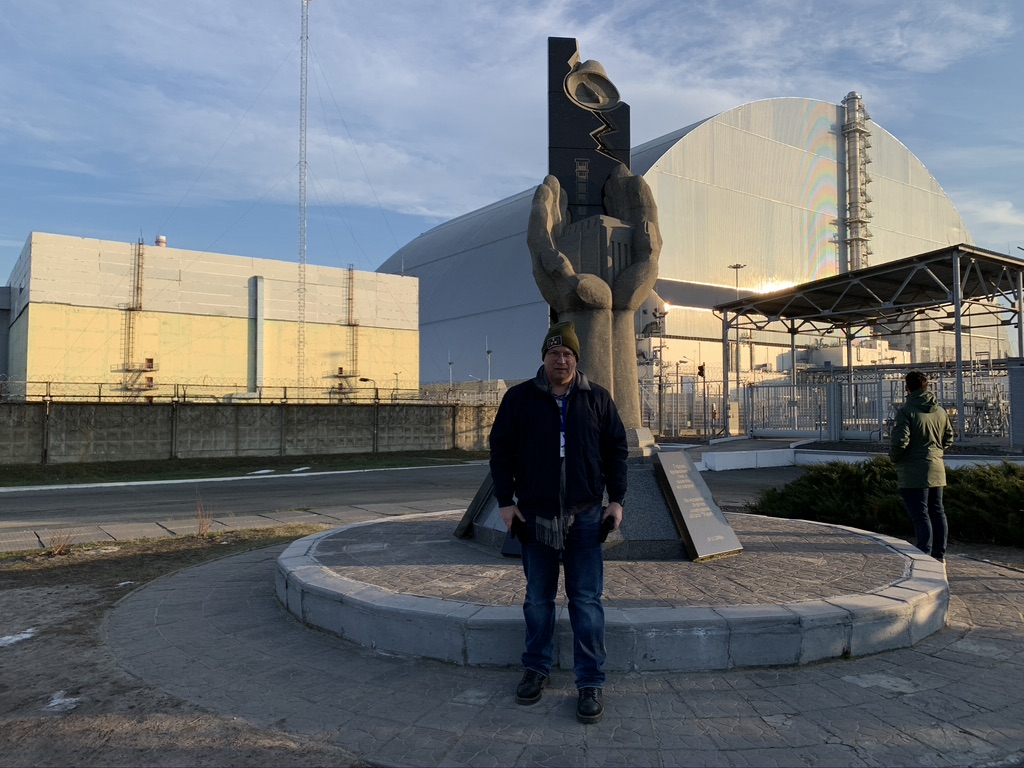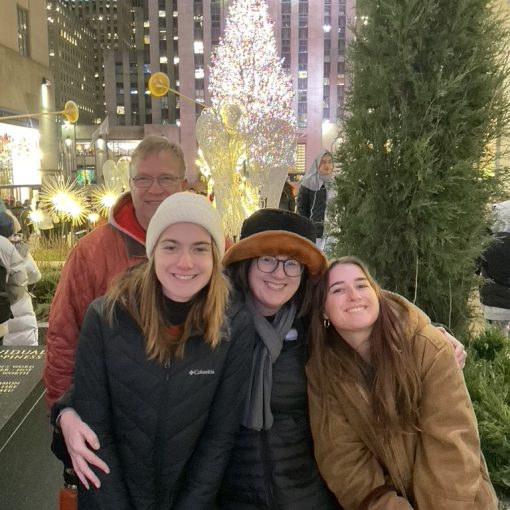In December 2019, I was in Kiev on a business trip, with a free weekend. What can you do with a weekend of free time in Kiev, Ukraine? Turns out, quite a lot. Kiev is a beautiful city with amazing shopping, restaurants, war memorials, ornate churches, etc. No shortage of things to do. But it’s also not far from the site of the world’s worst nuclear disaster, the Chernobyl NPP (Nuclear Power Plant). I had heard that there were tour companies offering single and multi-day tours. But I also heard they were quite expensive. Perhaps they were at one time, but my search found several highly-rated tour companies that offered full day tours out of Kiev for around $100. Most surprisingly, the reviews for these tours were… “glowing“! I was sold.
Our tour left early in the morning, December 7th 2019, from a centrally located train station. There was a long line of travel vans, including some very comfortable Mercedes Sprinter vans.

Every one of my Kiev based business partners said the same thing to me when I told them I was going on a Chernobyl tour, “I have never done that and have no interest in doing it!” Was it only the crazy international travellers participating in this nonsense?
The first stop was a passport check at the entrance to the exclusion zone. The portable souvenir shop was well stocked.



After checking our passports, they gave us a sensor which would record our radiation exposure for the duration of our time in the zone. At the end of the tour, each participant received a certificate with the total dose of gamma radiation recorded on these devices.

For an additional $10, we could rent a dosimeter which measures gamma radiation. Normal background radiation is 0.10 – 0.30 microsieverts per hour. So far so good…

Our first stop was an abandoned village just inside the exclusion zone.
Like a scene out of a dystopian horror movie… Although it was dangerous to walk around inside some of these buildings, nothing was off limits. The floors were ripped up because that’s where most families would store their valuables. Vandals knew this, of course, so those were the first areas in a home that were damaged. But, you could still find children’s stuffed animals and notebooks with school work.

The radiation near the structure’s drainage areas were much higher than normal. This is just a bit higher than the level of radiation you would be exposed to on a transoceanic flight. The danger from radiation is function of both the intensity of radiation and total time of exposure. Brief exposure to radiation at this level isn’t so bad, but extended exposure over many months and years can be very dangerous.
A few more miles and we were getting close. We saw an unfinished cooling tower and the remains of reactor #5, which was under construction at the time of the explosion. The morning of the explosion, almost 300 workers clocked in for the morning shift. Construction was halted 6 months after a 6-month shutdown. It will likely remain in this state for a long time. Demolition inside the zone is prohibited due to the danger from radioactive dust.
We turned a corner and there she was. We stopped about a mile away for a photo. My wife responded when I texted her the photo, “Look at the cute newlyweds honeymooning at Chernobyl!” We would get a lot closer, but first we took a turn to the left to take a tour of the nearby city of Pripyat.
Fifty thousand people lived here at the time of the explosion. They were quickly evacuated, told that they would return after 3 days. We were not allowed to go inside the hospital, the basement still contains the highly-radioactive outer garments the firefighters wore.
The playground was nearly completed for the May Day celebrations in 1986. The rollercoaster was not finished and has never been ridden.
The gym and pool were open for a decade after the explosion, serving the workers who did the initial cleanup. They finally closed in the mid 90’s and have fallen into disrepair.
After the walk through Pripyat, we returned to the the power plant. Reactor #4 is 300m behind me under a “New Safe Confinement”, the largest mobile structure in the world. At 250m wide and 108m tall, the 93m tall Statue Of Liberty would easily fit inside. The NSC was designed to last 100 years and give Ukraine and the world time to come up with a plan to disassemble the original sarcophagus using robotics. They don’t yet know what they’ll do with the contaminated material, but at least they’ve got some time to come up with something. Interestingly, this was the only point where we are kindly asked to restrict our photos. The guide asked us only to photograph in the general direction of the reactor. Not sure why, since there wasn’t much to look at in any other direction. Just an empty parking lot when we were there.
This was as close as we got to the site of the accident. Surprisingly, our dosimeters were not lighting up here. We got much higher readings driving through the Red Forest. For about 30-seconds every device in the bus started beeping loudly, peaking around 4 – 5 microsieverts per hour. I can’t imagine how high the numbers would have been near the ground if we had stopped there and walked into the forest. That area is still extremely contaminated.
The highest reading I saw on my device during the tour was around 36 microsieverts per hour. It was at the Pripyat River Port Cafe. I put my device on the ground at the crevice of the last concrete step to the dock, where rain would certainly pool up. Holding the device at waist high would lower the reading by a factor of 10.
After leaving the reactor, it was time for lunch. We stopped at the large commissary not far from the NPP. This is the only restaurant inside the zone and is used by the construction workers and tour groups. First, we all had to go through a body scanner to check for radiation. Once we cleared that, we headed upstairs to the restaurant. Food was served lunchroom style: Chicken and rice, Borscht, bread, salad, and beverages. Not the best food in Kiev. A fellow tourist referred to this as “prison food”. I laughed in agreement.
The next part of the tour came as a bit of a surprise, the Duga Radar facility. We took the main road as if we were leaving Chernobyl, but turned onto a dirt road near this bus stop.

Turns out this bus stop was a ruse. There were no busses that travelled this road ever. It was designed to give cover to the road as heading out to a summer camp, instead of a highly secretive military installation. Seemed like a 1/2 mile or more down a dirt road before we came upon this monstrosity.
This massive antenna structure was a giant radar system designed to detect ballistic missile launches from over the horizon. The scale of this structure is impossible to capture in pictures. “Breathtaking” only begins to describe it. It’s 500 feet tall and about a 1/2 mile long. This was the receiver part of the radar. The transmitter was located some 40 miles away. Unfortunately, it never worked as intended, set off false alarms, and cost nearly twice as much to build as the nearby nuclear power plant at 7 billion Russian rubles. Today, the facility can probably claim the title as the “World’s most expensive cell phone tower”. Coverage was pretty good here. There really is a modern functioning cell phone antenna mounted on the structure.

Saw a couple funny sights walking around the facility:
Overall this was an amazing tour. It far exceeded my expectations. The tour guides and drivers were all wonderful – knowledgeable and helpful. I would highly recommend taking this tour. It’s easy to see why travel sites are filled with 5-star reviews for these tours! In fact, I would encourage you to travel to Ukraine, when the world opens up, not only to take this incredible tour but to experience a wonderful country!














































